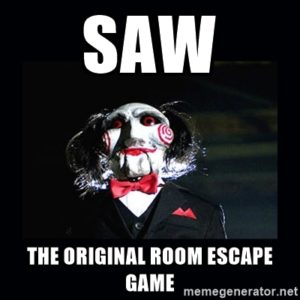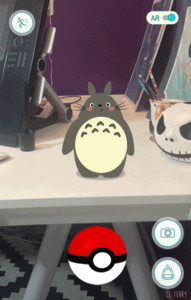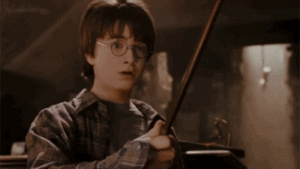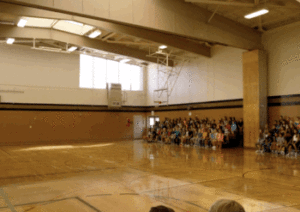As more and more virtual reality headsets start flowing into American households, the emergence of augmented reality is one of the biggest stories in technology right now. When I think of AR, I imagine futuristic terminator-like glasses, continually scrolling data through a visual overlay. However, AR shouldn’t be only a thing for killer robots. Black Mirror ep 1 season 3 give us a glimpse of a future where bionic eyes would visualize in real time the social media feeds of by-passers, with all the consequences on social relationship that could derive. While we might not be so far from making these scary technologies real – give a look to the $1.4 billion Magic Leap project making terminator-like glasses in Florida– such deep level of integration between digital and physical reality is still a dream for scientists and futurists.
To a lower extent, many of the technologies available in the current market already make augmented reality accessible for brands that want to engage their customers in a different kind of experience. The diffusion of internet of things, incredible penetration rate of smartphones, improvement of movement tracking technologies and rise in cognitive level of artificial intelligence, are key elements to bring AR in this world.
In summer 2016, for example, Pokémon Go introduced millions of players to the possibilities of smartphone-enabled AR. Players had to walk through their cities, searching for virtual monster that would appear in the real world thanks to their phones’ camera. The interest for the game died as fast as it rose, but it showed the way for other brands that could follow and improve the experiment. Intelligent billboards are also becoming more common, using artificial intelligence and wireless connection to recognize people or objects nearby and adapt the content advertised, like in Minority Report famous mall scene. One of the pioneers in this field was Ogilvy London, that in 2014 gave birth to a magical campaign for British Airways, including a series of digital billboards featuring a child pointing at planes flying over the area and messages related to that flight.
It is early to say exactly how brands will market on AR headsets, but it is worth to explore how the current digital-physical integration can help the narration and experience of the brand. This is why, as an entrepreneurial marketer, I started to ask myself: What AR is good at doing? What people like of it? how could we use current AR technologies for a marketing campaign?
Opportunities
Quest – Videogame culture trained my generation – born around 1990 and beyond – to the entertainment of the virtual quest: exploring spaces, finding hidden objects, advancing in levels and accumulate experience measured with scores for specific abilities. Escape rooms, a fast-growing entertainment where players have to solve complicate puzzles to free themselves from decorated prisons, bring videogame-like quests into real life.
Escape rooms require much set up work to be fully effective, with a consequent limit on user accessibility and number of levels developed. However, with the geolocation of our smartphones, we could transform any physical space into an escape room. Pokémon Go gave us a glimpse of what an AR enabled quest-game could look like: virtual elements scattered across locations in the physical world, and the smartphone as a tool to guide users in their discovery. For marketing purpose, creating a quest game might be a valuable opportunity for brands who want to engage their customer base and position themselves through the characteristics of adventure, wit, and exclusivity – a brand that only the best can master. Virtual hints, hidden in the real world, could drive the user though levels and accomplishments. Completing the quest would be rewarded with something that only the brand could give its customers, and is enough desirable to fill their motivation to continue the quest.
Build vision inside mobile screens – Artificial intelligence has gone a long way from solving math problems and chess games. One of the most useful abilities for AR advertising is that of recognizing increasingly more complex images. Google translate uses this feature to translate instantaneously any text in foreign language captured through the phone’s camera. Volkswagen brought the concept in the outer world, creating special billboard that would virtually animate when captured with a phone’s camera. Similar concept has been adopted for advertising stunts by other brands, such as the magical cover for the New Yorker in May 2016. However, animating billboards tend to be a difficult operation, that requires too many steps on the side of the user to become real – download the image recognition app, find a billboard to capture, take a picture, wait the result – and take little consideration of users’ motivation – apart the wow effect, why should I take a picture of a billboard? This is why L’Oréal used AI to create something its customer base would find more useful: a “magic mirror” app that uses to face-recognition function similar to Snapchat filters to let users try different shades of make-up on their face. As the users try the products and choose the ones they prefer, the app tracks all customer uses, learn preferences and tailor responses based on similar customers’ choices. Bringing products in the hands of consumers, the consideration for L’Oréal “magic mirror” goes beyond the wow effect. L’Oréal magic mirror is an enjoyable experience that quickly lead customers along the path from consideration to purchase and into the loyalty loop.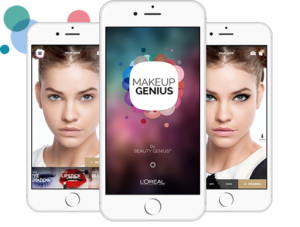
Internet of things – The more things are connected across the world, the more opportunities arise to create value out of these connections. How is good for marketing? The obvious answer would be to provide targeted ads to people passing by, recognize users and interact personally. Such level of one-to-one segmentation is still a futuristic objective, and possibly one that would challenge our current sense of privacy. However, Google is paving the way, with its recent announcement that it will install a series of billboards in London using DoubleClick technology to change ads displayed based on real-time data. A second opportunity would be the integration between various objects in the real world and information displayed on the billboard. The 2014 British Airways ad campaign was an example of how the presence of objects nearby the billboard – in that case, planes flying over the signage – would change the content of the ad. In 2014, Cisco promoted its Cisco Live event with a digital billboard on the highway near San Francisco airport, displaying messages of various length based on the speed of drivers approaching the signage. At Universal Studios, visitors walking within the Harry Potter citadel can buy special magic wands and use them to make some magic tricks happen in specific interactive shop-windows.
On a digital level, this experience have been recreated in many interactive shop-windows, such as Adidas “window shopping experience”, that let passerby play with an interactive screen, choosing products on the digital platform before walking into the store. Martin Mohr, Creative Director at TBWA who oversaw the Adidas experiment, said that 1 in 4 of the people who interacted with the screen actually walked in the store, and each player playing with the screen got 90% of the street’s attention. The opportunity to create digital spaces that respond to movements, objects and information from the physical space is there, and consumers are interested in what might come next.
Threats
The road to innovation is paved with large potholes.
A costly technology – In first place, integrating augmented reality in a marketing campaign can prove extremely expensive. Developing image recognition systems is costly, and so are the interactivity elements, prototyping and testing. Once all parts are developed, the ad must be delivered to the audience. On one side, the high cost of installing outdoor billboards can limit the number of installments, and therefore their reach. However, even a small audience could prove useful if the campaign is promoted through case study videos and media coverage that extend the reach of the campaign. On the other side, mobile phone based solutions might seem less expensive, since the cost per development could be spread over a possibly large user base. However, motivating people to download a branded app and use it to view the AR content you created might prove more difficult than expected.
Why you did it? – The use of AR should make sense for the brand and user need. Of course, there is a strong temptation to adopt AR in a marketing campaign for the sole purpose of generating “wow” expression on the user face, and possibly initiate word of mouth. However, without a clear concept that relates to the brand positioning, it would be harder to generate anything more than the wow face. Volkswagen tried it on its own skin with the 2012 beetle campaign: less users than expected went to the website, downloaded the app and pointed it to the outdoor billboards to see beetle cars flying around. The campaign had all the elements to fascinate the audience, but no reason to motivate the download of the app beyond the fascination. On the other side, the 2014 British Airways campaign successfully engaged the audience with its simplicity and emotional element. Everyone could see himself represented in the fascination of the kid pointing to the planes, and the simple copy connected the advertising to the brand vale proposition: we bring people to more than 80 destinations across Europe.
Recommendations
In conclusion, my recommendation to marketers who want to embrace AR is to keep exploring with a purpose. “Engaging consumers is the holy grail of advertisers”, says Antony Young – CEO of Mindshare North America. Well executed AR has the magical power to astonish people: make them willing to follow the rabbit and search for more information. However, only the campaign that use the technology to improve the brand positioning will see a significant return over their investment. It is an early time for the technology, and failure is a possibility to embrace: make sure you study the reasons of your failure as well as your success, so you can improve the next round.
References:
Young, A. (2010) Brand Media Strategy, Palgrave McMillian: New York.
Edelman, D.C., Singer, M. (2015) Competing on Customer Journey, Harvard Business Review, November 2015.
Anonymous (2014) Case study: Adidas Window Shopping, retrieved at http://www.best-marketing.eu/case-study-adidas-window-shopping/
Horowitz, R. (2013) How augmented-reality ads could change everything, retrieved at https://www.cnet.com/news/how-augmented-reality-ads-could-change-everything/
Condliffe, J. (2015) Google’s Testing Web-Style Responsive Ads on Huge London Billboards, retrieved at http://gizmodo.com/googles-testing-web-style-responsive-ads-on-huge-london-1739989584
Robinson, T. (2016) Black Mirror’s third season opens with a vicious take on social media, retrieved at http://www.theverge.com/2016/10/24/13379204/black-mirror-season-3-episode-1-nosedive-recap
Farber, D. (2013) The next big thing in tech: Augmented reality, retrieved at https://www.cnet.com/news/the-next-big-thing-in-tech-augmented-reality/
Finenberg, S. (2014) Cisco Launches Connected Billboard in San Francisco, retrieved at http://adage.com/article/btob/cisco-launches-connected-billboard-san-francisco/293168/
Smith, C. (2016) Augmented reality turns a print magazine into a digital wonder, retrieved at http://bgr.com/2016/05/09/the-new-yorker-augmented-reality-cover/
D&AD (2015) Case Study: British Airways Magic of Flying, retrieved at https://www.dandad.org/en/d-ad-ba-magic-of-flying-case-study-insights/
Delallo, L. (2017) How businesses are using AI: An interactive guide, retrieved at https://www.ibm.com/blogs/watson/2017/01/cognitive-ai-technologies-interactive-guide-businesses-already-using/
Kelly, K. (2016) HYPER VISION, retrieved at https://www.wired.com/2016/04/magic-leap-vr/


